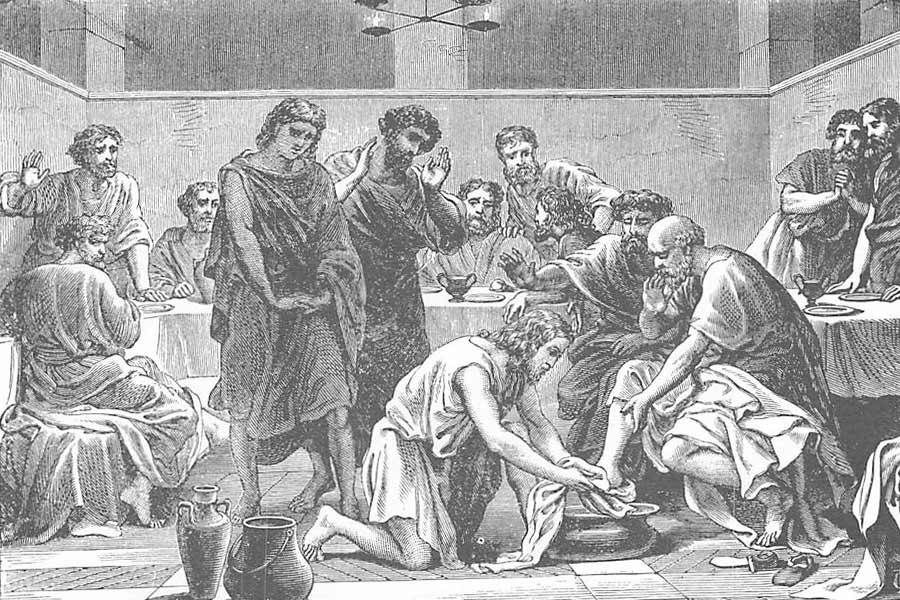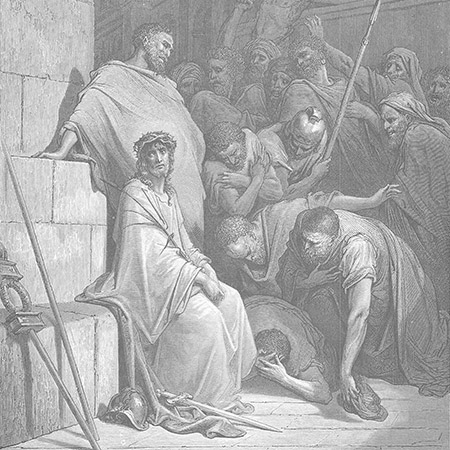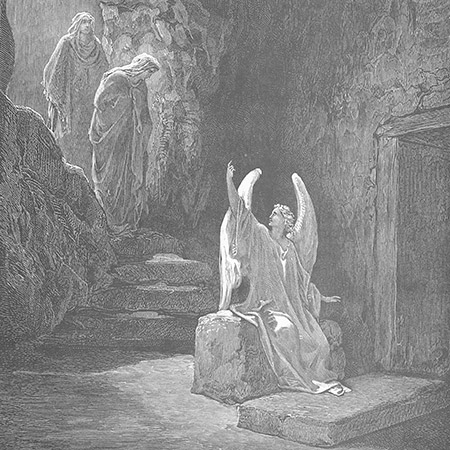The Final Week: A Deconstruction of the Week that Saved the World (Part 2)

Jesus washing Peter's feet. (John 13:6-11)
Join us in commemorating the final week of Our Blessed Lord’s life on earth by taking a deconstructed look at the most important week in Christianity — the events that saved the world and created new life for us.
Along with sharing a summary of each day of Holy Week, we invite you to jump into the Scriptures to read the accounts in full. Enjoy this look at the who, what, where, when, and why — plus, how we commemorate those events.
This article takes us from Holy Thursday to Easter Sunday. Palm Sunday to Silent Wednesday are covered in part one of "The Final Week."
Holy Thursday: Jesus sends Peter and John to prepare the Passover meal in the Upper Room. In the evening, Jesus washes the feet of the Apostles, setting a model of servitude and other-directed love that John’s Gospel extols as so essential to Christianity, that, without it, we cannot call ourselves disciples of Christ. During the Passover meal, Jesus foretells the betrayal by Judas, who leaves before the supper is finished.
On this night before His crucifixion, Jesus institutes the sacraments of the Eucharist and the priesthood. To better understand the former, we must take a step back and consider it in context. The liberation of the Israelites from slavery in Egypt was such a watershed moment in the Chosen People’s history, that it was only natural for Israel to commemorate it in solemn fashion. The Jews did this by sacrifice — drawing from an existing rite of sacrifice of lambs in the springtime — and turning that into a thanksgiving sacrifice to the one true God. The lambs were brought into the temple where the priest would slaughter them and sprinkle the blood on the altar of holocausts before giving them back to the community or family.
Joan Carter McHugh in Eucharist: God Among Us, writes: “That ancient sacrifice is given a new and nobler meaning when the paschal lamb becomes Christ and the paschal supper becomes the Eucharist.”
Jesus inserts Himself into this ritual supper by offering Himself “as the lamb who is slain and who must be eaten during the Passover celebration. He concludes this, of course, on Good Friday when He dies on the cross,” explained Father Joseph Keating, Pastor of Nativity of the Blessed Virgin Mary Parish in Penelope and Immaculate Heart of Mary in Abbott.
Saying the words of consecration, Jesus changes the bread and wine into His own body and blood. Historians say that in Aramaic (the language of Jesus) there is no “to be” verb. So Jesus plainly says, “This — My Body,” and “This — My Blood.” No room for symbolism there.
He then commands His disciples — and by extension their successors — to do the same “in memory of me” (Luke 22:19). With these actions, Jesus deliberately joins “together the final Pasch [Passover] and the first Eucharist” McHugh writes — at the same time instituting the priesthood (the Apostles wouldn’t have dared repeat the rite unless the Master told them so). Hence, throughout the centuries at every Mass, and until Christ comes again, the bread and wine offered by the priest is transubstantiated into Christ’s own body and blood.
McHugh breaks it down further: “At the first Passover, God saved His people from death….At His last Passover, Jesus saved the whole world from death.”
Thus, Jesus perfects and completes what the Old Testament and the many covenants made before had started and we see how sacred history is connected from past to present.
Modern Day: During the Holy Thursday liturgy, the priest, representing Christ, washes the feet of laypeople in an act of humility and service. The Last Supper is commemorated and priests all over the world renew their vows. Altars are stripped of decoration, the church is darkened, and the Blessed Sacrament is processed to a place of quiet and repose where the faithful can adore Him for a while — a commemoration of the events in the Garden of Gethsemane. The tabernacle is left empty and open, signifying that Christ is not there.

Good Friday: At around 2 a.m., the “hour of darkness,” Judas betrays Jesus with a kiss and He is arrested by the Sanhedrin guards.
The six trials of Jesus begin: before Annas; before Caiphas and members of the Sanhedrin; before the entire Sanhedrin at dawn; before Pilate; before Herod; and before Pilate again. During all this, Peter denies Jesus and repents; Judas commits suicide.
Around noon, Pilate gives in to the raucous crowds and hands Jesus over to be crucified. Scourged, beaten, and mocked, Jesus carries the cross about ¼ mile to Golgotha and is crucified — the most painful death that could be inflicted in the ancient world, according to historians. Significantly, at around the same time, the Passover lambs were slaughtered in the temple. All of this takes place less than 24 hours since Jesus’ lips uttered: “This is my body which will be given up for you”(Luke 22:19). At around 3 p.m., Jesus takes a sip of vinegar and gall offered by the centurion (it’s no coincidence that it’s a species of wine) and speaks His last words: “It is finished,” and, “into Your hands I commend My spirit.”
“Those [actions] are particularly meaningful because they complete the institution of the Eucharist,” Fr. Keating said. “It completes the Passover sacrifice.”
Why is the Paschal sacrifice not concluded until this moment? Because during the course of the Last Supper (or Passover seder), Jesus had taken only three of the four cups of wine the ritual supper dictates. Theologian Scott Hahn says the sour wine on the sprig of hyssop is the “fourth cup” that Jesus deliberately omitted the night before. With this fourth cup of “suffering and death” Jesus completes the Passover sacrifice, becoming the “new and eternal Paschal Lamb,” McHugh writes (Mark 14:25). Of course, this reality escapes the disciples until Sunday, as we see with the events at Emmaus.
Our Lord’s side is pierced. The Temple veil is torn. Jesus is hastily taken down and buried in the unused tomb of Joseph of Arimathea.
Modern Day: This is the most solemn day in the Church’s calendar. It’s a mandatory day of fasting and abstinence. We commemorate the moment of our salvation, our reconciliation with the Creator, on this day. We venerate the Cross with a kiss or bow during the Liturgy of the Lord’s Passion. No Masses or sacraments are celebrated. The Passion narrative is again read during the service. The Communion we receive today is from the night before. Parishes usually offer other Good Friday devotions like Stations of the Cross.

Holy Saturday: Jesus’ body lies in the tomb on the Sabbath and the disciples mourn His death. The guards keep watch and set a seal on the tomb to prevent anyone from stealing the body. Holy Saturday also commemorates the day that Jesus “descended into hell” to free the just and righteous who had gone before Him.
Modern Day: Like the disciples, we too keep vigil for the resurrection of Our Lord. It is highly recommended that the faithful take this day to meditate on Christ’s passion and death, and to continue practices of prayer and fasting as they await His resurrection. Paschalis Sollemnitatis (on the Preparation and Celebration of the Easter Feasts) encourages Catholics to meditate on the Office of Readings and/or the image of Christ crucified lying in the tomb.
At night, the Easter Vigil — “the solemnity of solemnities” as Paschalis Sollemnitatis puts it — is celebrated. The vigil Mass, a celebration that can take up to three hours, has four parts:
1. The Service of Light, during which a new paschal candle is blessed. Beginning outside, the priest and people process into the darkened church led by the light of the paschal candle — symbolic of us following the Risen Christ. Next follows the great Easter hymn (or proclamation) the Exsultet.
2. The Liturgy of the Word, during which the Church meditates on the wonderful works of God from the earliest of times (hence seven Old Testament and two New Testament readings), and this climaxes with the Gospel and homily.
3. The Liturgy of Baptism, during which hundreds of candidates and catechumens throughout the diocese are brought into full communion with the Church. Catechumens (those who have never been baptized) receive the sacraments of Baptism, First Communion, and Confirmation. Candidates enter the Church through a profession of faith, reception of the Eucharist, and Confirmation. The faithful renew their baptismal promises.
4. The Liturgy of the Eucharist, during which the faithful are called to Holy Communion.
Easter Sunday: On the third day, Jesus rises from the grave and appears to Mary Magdalene; the other women who came to the tomb; to the two disciples on the Road to Emmaus; to Simon Peter; and to the astonished disciples (sans Thomas).
The experience at Emmaus (Luke 24:13-35) is a “priceless gift,” to the disciples and to us, McHugh writes, for through it, we are reminded yet again that “there are many ways in which Christ is present to His Church, but at the heart of it all is His substantial, real, permanent presence in the Eucharist. When our hopes and dreams are shattered, we too can count on Him to restore us to life, just like He did to the Emmaus disciples.”
Of course, this life is not just earthly but eternal! As the previous edition of the Memorial Acclamation stated, “Dying He destroyed our death, rising He restored our life.”
This day is “everything to us as Christians,” Fr. Keating explained. “If there’s no Easter, then there’s no Christianity. I know Christmas seems like a bigger deal in our secular culture, but Easter is the bigger deal because while the birth of our God is amazing, the resurrection of our God is the moment we win.
“Sunday is the big win. It’s the victory,” he added. “Everything is about celebrating the resurrection of Jesus from the dead. If Christ is not raised then our faith is in vain...If we belong to Christ in this life, then we will also rise with Him.”
Modern Day: The culmination of Lent and the most important day of the Church calendar, Easter Sunday, reminds us of the promise of our own resurrection into eternal life.
Churches celebrate with joyful early morning liturgies. After Mass, some churches offer Easter egg hunts (the egg symbolizes new life or rebirth). Christians are encouraged to spend time in community and with family.
And one more thing, Easter continues for 50 days! This is just the start of the celebration.
